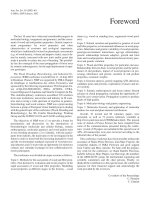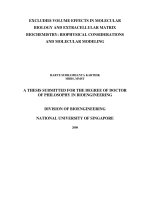Progress in molecular biology and translational science, volume 141
Bạn đang xem bản rút gọn của tài liệu. Xem và tải ngay bản đầy đủ của tài liệu tại đây (13.72 MB, 389 trang )
VOLUME ONE HUNDRED AND FOURTY ONE
PROGRESS IN
MOLECULAR BIOLOGY
AND TRANSLATIONAL
SCIENCE
Ubiquitination and
Transmembrane Signaling
VOLUME ONE HUNDRED AND FOURTY ONE
PROGRESS IN
MOLECULAR BIOLOGY
AND TRANSLATIONAL
SCIENCE
Ubiquitination and
Transmembrane Signaling
Edited by
Sudha K. Shenoy
Department of Medicine, Duke University
Medical Center, Durham, NC, United States
AMSTERDAM • BOSTON • HEIDELBERG • LONDON
NEW YORK • OXFORD • PARIS • SAN DIEGO
SAN FRANCISCO • SINGAPORE • SYDNEY • TOKYO
Academic Press is an imprint of Elsevier
Academic Press is an imprint of Elsevier
125 London Wall, London EC2Y 5AS, United Kingdom
525 B Street, Suite 1800, San Diego, CA 92101-4495, United States
50 Hampshire Street, 5th Floor, Cambridge, MA 02139, United States
The Boulevard, Langford Lane, Kidlington, Oxford OX5 1GB, UK
First edition 2016
Copyright © 2016 Elsevier Inc. All Rights Reserved.
No part of this publication may be reproduced or transmitted in any form or by any
means, electronic or mechanical, including photocopying, recording, or any
information storage and retrieval system, without permission in writing from
the publisher. Details on how to seek permission, further information about the
Publisher’s permissions policies and our arrangements with organizations such as
the Copyright Clearance Center and the Copyright Licensing Agency, can be
found at our website: www.elsevier.com/permissions.
This book and the individual contributions contained in it are protected under
copyright by the Publisher (other than as may be noted herein).
Notices
Knowledge and best practice in this field are constantly changing. As new research
and experience broaden our understanding, changes in research methods, professional practices, or medical treatment may become necessary.
Practitioners and researchers must always rely on their own experience and
knowledge in evaluating and using any information, methods, compounds, or
experiments described herein. In using such information or methods they should
be mindful of their own safety and the safety of others, including parties for whom
they have a professional responsibility.
To the fullest extent of the law, neither the Publisher nor the authors, contributors,
or editors, assume any liability for any injury and/or damage to persons or property
as a matter of products liability, negligence or otherwise, or from any use or operation
of any methods, products, instructions, or ideas contained in the material herein.
ISBN: 978-0-12-809386-3
ISSN: 1877-1173
For information on all Academic Press publications
visit our website at />
Publisher: Zoe Kruze
Acquisition Editor: Mary Ann Zimmerman
Editorial Project Manager: Helene Kabes
Production Project Manager: Magesh Kumar Mahalingam
Designer: Maria Ines Cruz
Typeset by Thomson Digital
CONTRIBUTORS
A. Conte
IFOM, The FIRC Institute for Molecular Oncology Foundation, Milan, Italy
C. Crudden
Department of Oncology and Pathology, Cancer Center Karolinska, Karolinska Institutet and
Karolinska University Hospital, Stockholm, Sweden
N.J. Freedman
Department of Medicine (Cardiology), Duke University Medical Center, Durham, NC,
United States; Department of Cell Biology, Duke University Medical Center, Durham, NC,
United States
T. Fukushima
Departments of Animal Sciences and Applied Biological Chemistry, Graduate School of
Agriculture and Life Sciences, The University of Tokyo, Tokyo, Japan; Department of
Biological Sciences, Faculty of Bioscience and Biotechnology, Tokyo Institute of
Technology, Kanagawa, Japan
H. Furuta
Departments of Animal Sciences and Applied Biological Chemistry, Graduate School of
Agriculture and Life Sciences, The University of Tokyo, Tokyo, Japan
A. Girnita
Department of Oncology and Pathology, Cancer Center Karolinska, Karolinska Institutet and
Karolinska University Hospital, Stockholm, Sweden; Dermatology Department, Karolinska
University Hospital, Stockholm, Sweden
L. Girnita
Department of Oncology and Pathology, Cancer Center Karolinska, Karolinska Institutet and
Karolinska University Hospital, Stockholm, Sweden
F. Hakuno
Departments of Animal Sciences and Applied Biological Chemistry, Graduate School of
Agriculture and Life Sciences, The University of Tokyo, Tokyo, Japan
M.A. Harrison
School of Biomedical Sciences, University of Leeds, Leeds, United Kingdom
P.-Y. Jean-Charles
Department of Medicine (Cardiology), Duke University Medical Center, Durham, NC,
United States
ix
x
Contributors
S.M. Lamothe
Department of Biomedical and Molecular Sciences, Queen’s University, Kingston,
Canada
P. Penela
Department of Molecular Biology and Centre of Molecular Biology “Severo Ochoa”
(CSIC-UAM), Madrid, Autonomous University of Madrid, Madrid, Spain; Spain Health
Research Institute The Princesa, Madrid, Spain
S. Ponnambalam
School of Molecular & Cellular Biology, University of Leeds, Leeds,
United Kingdom
S.K. Shenoy
Department of Medicine (Cardiology), Duke University Medical Center, Durham, NC,
United States; Department of Cell Biology, Duke University Medical Center, Durham, NC,
United States
S. Sigismund
IFOM, The FIRC Institute for Molecular Oncology Foundation, Milan, Italy
G.A. Smith
School of Molecular & Cellular Biology, University of Leeds, Leeds, United Kingdom
J.C. Snyder
Department of Cell Biology, Duke University Medical Center, Durham, NC,
United States
S.-I. Takahashi
Departments of Animal Sciences and Applied Biological Chemistry, Graduate School of
Agriculture and Life Sciences, The University of Tokyo, Tokyo, Japan
D.C. Tomlinson
School of Molecular & Cellular Biology, University of Leeds, Leeds, United Kingdom
M. Torres
Georgia Institute of Technology, School of Biology, Atlanta, GA, United States
R.J.H. Wojcikiewicz
Department of Pharmacology, SUNY Upstate Medical University, Syracuse, NY,
United States
C. Worrall
Department of Oncology and Pathology, Cancer Center Karolinska, Karolinska Institutet and
Karolinska University Hospital, Stockholm, Sweden
F.A. Wright
Department of Pharmacology, SUNY Upstate Medical University, Syracuse, NY,
United States
Contributors
H. Yoshihara
Departments of Animal Sciences and Applied Biological Chemistry, Graduate School of
Agriculture and Life Sciences, The University of Tokyo, Tokyo, Japan
S. Zhang
Department of Biomedical and Molecular Sciences, Queen’s University, Kingston,
Canada
xi
PREFACE
Transmission of diverse extracellular signals to the intracellular biochemical
machinery is mediated by cell-surface receptors, and the intracellular chemical reactions triggered by these receptors elicit specific physical or physiological cellular responses. Three classes of cell-surface receptors constitute
the primary conduits of transmembrane signaling: (1) chemically gated,
multitransmembrane ion channels, (2) seven-transmembrane receptors,
or G protein–coupled receptors, and (3) single-transmembrane, kinasecontaining enzymic receptors. Accumulating evidence indicates that the
posttranslational modification called ubiquitination has a significant impact
on the strength and duration of transmembrane signaling. For most cellsurface receptors, ubiquitination of the receptor protein dictates its expression level and longevity. Additionally, for almost all cell-surface receptors
ubiquitination regulates intracellular trafficking, signaling activity, and
protein–protein association that can create intracellular signaling complexes
of receptors and other intracellular proteins.
This volume summarizes the current state of knowledge on ubiquitination
of cell-surface receptors, associated kinases, effectors, and adaptors. Chapter 1
(P.-Y. Jean-Charles et al.) describes the roles of ubiquitination in the regulation
of the largest family of cell-surface receptors—namely, seven-transmembrane
receptors (7TMRs, also known as G protein–coupled receptors or GPCRs).
Chapter 2 (M. Torres) discusses the relationship between ubiquitination of
heterotrimeric G proteins and their signaling. Chapter 3 (P. Penela) presents an
overview of ubiquitin-dependent regulation of GPCR kinases and the impact
of their ubiquitination on signal transduction. Chapter 4 (F.A. Wright and
R.J.H. Wojcikiewicz) summarizes how ubiquitination regulates inositol 1,4,
5-trisphosphate receptor–mediated Ca2+ responses in the cell. Chapter 5
(S.M. Lamothe and S. Zhang) is a comprehensive review of ubiquitindependent downregulation of ion channels and ion transporters. Chapter 6,
(A. Conte and S. Sigismund), Chapter 7 (L. Girnita et al.), and Chapter 8
(G.A. Smith et al.) shed light on the ubiquitin-dependent regulation of growth
factor receptors and their signal transduction pathways. Chapter 9 (P.-Y. JeanCharles et al.) highlights the functional roles of ubiquitination and deubiquitination of the versatile adaptor proteins called beta-arrestins, which also act
xiii
xiv
Preface
as critical scaffolds that connect a number of cell-surface receptors with the
ubiquitination machinery.
I hope the information included in this volume will provide the readers
with a broad perspective on the importance of ubiquitination in the regulation of cell-surface receptors and the control of transmembrane signaling. This volume was made possible, of course, only by the outstanding
efforts of its contributors, to whom I am very grateful. I thank P. Michael
Conn, the Chief Editor of this series (Progress in Molecular Biology and
Translational Science), for providing me the opportunity to synthesize a
volume on the roles of ubiquitination in cell signaling. I also thank Mary
Ann Zimmerman, the Senior Acquisitions Editor and Helene Kabes,
Senior Editorial Project Manager of Elsevier, for their help. Finally, I thank
my postdoctoral mentor Robert J. Lefkowitz for introducing me to the
fascinating field of 7TMRs and signal transduction.
SUDHA K. SHENOY
Durham, NC
CHAPTER ONE
Ubiquitination and
Deubiquitination of G ProteinCoupled Receptors
P.-Y. Jean-Charles*, J.C. Snyder**, S.K. Shenoy*,**,1
*
Department of Medicine (Cardiology), Duke University Medical Center, Durham, NC, United States
Department of Cell Biology, Duke University Medical Center, Durham, NC, United States
**
1
Corresponding author. E-mail address:
Contents
1. Introduction
1.1 G Protein-Coupled Receptors
1.2 Ubiquitination and Deubiquitination
2. Ubiquitination of GPCRs
2.1 β2 Adrenergic Receptor
2.2 Chemokine Receptors
2.3 Proteinase Activated Receptors
2.4 Opioid Receptors
2.5 Noncanonical GPCRs and Ubiquitin Ligases
2.6 Yeast GPCRs
3. Deubiquitination of GPCRs
3.1 Overview
3.2 Recycling and Resensitization
3.3 Accelerated Degradation
3.4 Alternate Effects
4. Concluding Remarks
Acknowledgments
References
2
2
5
6
6
18
22
26
28
35
35
35
36
38
39
40
42
42
Abstract
The seven-transmembrane containing G protein-coupled receptors (GPCRs) constitute the
largest family of cell-surface receptors. Transmembrane signaling by GPCRs is fundamental
to many aspects of physiology including vision, olfaction, cardiovascular, and reproductive
functions as well as pain, behavior and psychomotor responses. The duration and magnitude of signal transduction is tightly controlled by a series of coordinated trafficking
events that regulate the cell-surface expression of GPCRs at the plasma membrane.
Progress in Molecular BiologyandTranslational Science, Volume 141
ISSN 1877-1173
/>
© 2016 Elsevier Inc.
All rights reserved.
1
2
P.-Y. Jean-Charles et al.
Moreover, the intracellular trafficking profiles of GPCRs can correlate with the signaling
efficacy and efficiency triggered by the extracellular stimuli that activate GPCRs. Of the
various molecular mechanisms that impart selectivity, sensitivity and strength of transmembrane signaling, ubiquitination of the receptor protein plays an important role
because it defines both trafficking and signaling properties of the activated GPCR.
Ubiquitination of proteins was originally discovered in the context of lysosome-independent degradation of cytosolic proteins by the 26S proteasome; however a large body of
work suggests that ubiquitination also orchestrates the downregulation of membrane
proteins in the lysosomes. In the case of GPCRs, such ubiquitin-mediated lysosomal
degradation engenders long-term desensitization of transmembrane signaling. To date
about 40 GPCRs are known to be ubiquitinated. For many GPCRs, ubiquitination plays a
major role in postendocytic trafficking and sorting to the lysosomes. This chapter will focus
on the patterns and functional roles of GPCR ubiquitination, and will describe various
molecular mechanisms involved in GPCR ubiquitination.
1. INTRODUCTION
1.1 G Protein-Coupled Receptors
G protein-coupled receptors (GPCRs), also known as seven-transmembrane
receptors (7TMRs), constitute the largest family of cell-surface receptors, and
are encoded by roughly 800 genes in the human genome.1 GPCRs transduce
specific intracellular signals in response to a wide variety of extracellular stimuli
that range from photons, ions, organic odorants, amino acids, lipids, nucleotides, peptides, and proteins (Fig. 1). Signal transduction by GPCRs is fundamental for most physiological processes and include vision, smell, and taste as
well as neurological, cardiovascular, endocrine, and reproductive functions.2–4
Consequently, the GPCR superfamily is a major target for therapeutic intervention and about 40% of prescription drugs target GPCR activity.5–7
GPCRs have a conserved structural architecture of seven transmembrane
helices that traverse the membrane bilayer such that the amino terminus is
exposed to extracellular milieu and the carboxyl terminus is intracellular in
contact with the cytoplasm. (Fig. 1) Upon ligand binding and activation,
specific conformational changes are triggered in the GPCR molecule. This
conformational switch facilitates GTP/GDP exchange on the Gα subunit of
bound heterotrimeric G proteins and results in the dissociation of active Gα
and Gβγ. This stimulates catalytic activation of various downstream effectors
(eg, adenylyl cyclase) and activation of kinase cascades and subsequent physiological responses.3 Agonist-activated GPCRs are rapidly phosphorylated
by cognate GPCR kinases or GRKs on specific intracellular seryl/threonyl
3
[(Figure_1)TD$IG]
Ubiquitination and Deubiquitination of G Protein-Coupled Receptors
Stimulus
(Light, ion, odorant, pheromone, peptide, proteins, and other molecules)
NH2
7-Transmembrane receptor
(GPCR)
Extracellular
Cell membrane
Intracellular
P P
HOOC
GRK
α
β
Desensitization
γ
G protein-dependent
signaling
β-Arrestin
β-Arrestin-dependent
trafficking
β-Arrestin-dependent
signaling
Figure 1 GPCR signal transduction. GPCRs have a characteristic heptahelical structure
with their N-terminus exposed to extracellular milieu and an intracellular C-terminus.
About 800 GPCRs are estimated to function as transducers for a whole array of stimuli
ranging from photons of light to small proteins in humans. Binding of an extracellular
stimulus to specific region(s) on the cognate GPCR activates the GPCR molecule and
triggers conformational changes in the transmembrane domains promoting the
coupling and activation of the heterotrimeric G proteins. Activated G proteins trigger
phosphorylation of signaling kinases and produce a cell response. Agonist-occupied
GPCRs are rapidly phosphorylated by the serine-threonine kinases called GPCR kinases
(GRKs). Phosphorylated GPCRs serve as high affinity binding receptacles for recruiting
and docking the cytosolic adaptors called β-arrestins. β-arrestins can physically interdict
G protein binding and cause rapid desensitization of GPCR signaling. GRK and β-arrestin
binding not only block signal transduction by G proteins, but they also promote GPCR
endocytosis and trigger alternate pathways of signal propagation leading to a G proteinindependent cell response(s).
residues. Phosphorylated GPCRs then recruit cytosolic adaptor proteins
called β-arrestins (β-arrestin1 and β-arrestin2; also called arrestin2 and
arrestin3).3,8–11 GRK phosphorylation and β-arrestin binding together
block G protein coupling and lead to signal desensitization. GPCRs also
elicit G protein independent signaling via β-arrestins, which bind to a host of
4
P.-Y. Jean-Charles et al.
signaling kinases.12–14 The adaptor function of β-arrestins also links activated
GPCRs with the endocytic machinery and initiates intracellular trafficking
of the receptor, mostly through clathrin-coated vesicles.8,14–18 However,
caveolin- or lipid-raft-mediated endocytosis as well as β-arrestin-independent internalization have also been reported.15,19–21 After internalization,
GPCRs localize in compartments called early endosomes where they can be
dephosphorylated and routed back to the plasma membrane via recycling
vesicles or alternatively GPCRs can be targeted to lysosomal compartments
for degradation. This degradation pathway serves as an “off switch” to
desensitize GPCR signaling for a prolonged duration (Fig. 2). GPCR signaling at the plasma membrane is revived by recycling of internalized
GPCRs back to the plasma membrane or by their de novo synthesis.
[(Figure_2)TD$IG]
Agonist
GPCR
Internalization
PP
β-Arrestin
Clathrin-coated
vesicle
GRK
Recycling
Early endosome
Recycling
endosome
Sorting
Degradation
Lysosome
Multivesicular body
(MVB)
Late endosome
Figure 2 Agonist-stimulated intracellular trafficking itinerary of GPCRs. Agonist stimulation
of GPCRs induces signaling via activated Gα and Gβγ units. This is followed by rapid
phosphorylation of the receptor’s intracellular domains by GRKs and triggers
recruitment of β-arrestins leading to uncoupling of G proteins (not shown). β-arrestins
serve as endocytic adaptors and facilitate receptor internalization into clathrin-coated
vesicles. Internalized GPCRs are then mobilized into early endosomes followed by their
journey to the late endosomes. The late endosomes fuse into multivesicular bodies and
eventually fuse with the lysosomes, which serve as degradation chambers for GPCRs.
During postendocytic sorting, GPCRs can be mobilized from the early endosomes into
recycling endosomes that will redirect and recycle GPCRs to the plasma membrane for
resensitization of receptor signaling.
Ubiquitination and Deubiquitination of G Protein-Coupled Receptors
5
GPCRs undergo many posttranslational modifications that can affect
their expression, localization, and functional properties. Among these, palmitoylation of conserved cysteines, phosphorylation of serines and threonines, and ubiquitination of lysines have been characterized for a number of
GPCRs.20–25 Ubiquitination is a pervasive modification that affects numerous pathways and proteins in a cell. Not surprisingly, a number of proteins
within the GPCR signal transduction cascades are also regulated by ubiquitination. This chapter will describe the functional consequences of GPCR
ubiquitination across a diverse sampling of GPCRs and the physiology that
they regulate. An overview of the mechanisms and the enzymatic machinery
that has been linked with GPCR ubiquitination will also be reviewed. The
chapters that follow will highlight the significance of ubiquitination of signal
transducers (G protein, Chapter 2; β-arrestin, Chapter 9), a kinase (GRK2,
Chapter 3), and a downstream effector (IP3R, Chapter 4).
1.2 Ubiquitination and Deubiquitination
Protein ubiquitination has been extensively studied for over three decades
and the reader is directed to excellent chapters or reviews for more information on this subject.26–33 Ubiquitination is an evolutionarily conserved
and reversible posttranslational modification in which the carboxyl terminus
of the 76 amino-acid long polypeptide ubiquitin (Ub) is covalently attached
to amino group (lysyl side chain or the amino terminus) of substrate proteins.
Often, successive rounds of ubiquitination occur so that Ub moieties are
attached to the previously appended Ub, thus allowing the formation of
polyubiquitin chains. Additionally, each Ub has 8 such attachment points
(amino terminus, and 7 lysines at positions 6, 11, 27, 29, 33, 48, and 63),
which facilitate the structural diversity of these chains.
Ubiquitination is achieved by the concerted activities of three types
of enzymes: Ub activating enzyme or E1, Ub conjugating enzyme or E2
and E3 Ub ligases. The E3 ligases define substrate specificity and timing of
ubiquitination and are categorized as either HECT (Homologous to E6AP
CarboxylTerminus) family ligases or RING (Really Interesting New Gene)
family ligases based on the structure of their catalytic domain. Human cells
express ∼30 HECT and ∼600 RING ligases that can selectively modify
substrates by direct binding or indirect interaction facilitated by adaptor
proteins. Ubiquitination is also reversed by specific enzymes called deubiquitinases (DUBs) that hydrolyze ubiquitin linkage from protein substrates.
About 100 DUBs have been identified in human cells most of them belonging to ubiquitin specific proteases (USP) family.
6
P.-Y. Jean-Charles et al.
Ub was originally branded as a tag for protein degradation. However, this
reversible modification is now considered as a pleiotropic tag that can regulate a wide array of cellular processes. This now includes protein activity,
protein trafficking, and protein–protein interactions.27 In general, poly-Ub
chains with lysine-48 linkage marks the modified substrate for 26S proteasomal degradation. On the other hand, Ub chains with lysine-63 linkage
signal vesicular trafficking or kinase activation via the modified protein.34
Aside from its role as a covalently linked tag, ubiquitin can also serve as a
binding platform for noncovalent association with a variety of ubiquitin
binding domains.30,35 Thus ubiquitin tags and their binding partners provide
a network of protein complexes with “ubiquitin codes” that are tailored for
each substrate to effect protein conformation, function, localization, and
perhaps signal transduction.
2. UBIQUITINATION OF GPCRs
A substantial number of GPCRs are known to be ubiquitinated. The
role of GPCR ubiquitination on internalization, signaling, vesicular trafficking, and/or degradation may vary based on the receptor type, ligand
identity and physiological factors involved. In general, ubiquitination of
GPCRs functions as an obligatory tag for postendocytic sorting of internalized GPCRs to the lysosomes.14,20,36–39 For some GPCRs, ubiquitination of the receptor is dispensable for lysosomal trafficking whereas for
other GPCRs, ubiquitination of the receptor induces their proteasomal
degradation. While ubiquitin does not generally function as a signal for
internalization of mammalian GPCRs, monoubiquitination is required for
the internalization of yeast GPCR STE2 and under certain conditions
polyubiquitination of mammalian GPCRs can serve as a trigger for
internalization.40–42 A list of GPCRs that have been shown to be regulated
by ubiquitination is presented in Table 1. Specific GPCR examples along
with the mechanisms involved are described in the following sections.
2.1 β2 Adrenergic Receptor
The β2 adrenergic receptor (β2AR) is a prototypical member of the GPCR
family cloned in the 1980’s.102 β2AR is widely expressed, and has been
extensively characterized over the years for its biological and physiological
roles.103,104 Recently, crystallographic studies have enabled visualization of
E3 Ligase
DUB
β-Arrestins
and Other
Adaptors
Constitutive
Cul3/Roc1
N.D.
N.D.
N.D.
[43]
Constitutive
N.D.
USP4
N.D.
ER Quality
control
[44]
Agonist-induced
NEDD4
USP20,
USP33
β-Arrestin2
[45–47]
Carvedilol-induced
MARCH2
No
Oxygen-dependent
pVHL E3
ligase
complex
N.D.
Lysosomal
degradation
Endocytosis and
lysosomal
sorting
Proteasomal
degradation
Angiotensin receptors
AT1 receptor
Via D5R Activation
N.D.
N.D.
N.D.
Proteasomal
degradation
[49]
Chemokine receptors
CCR7
Constitutive
N.D.
N.D.
N.D.
Recycling and
immune cell
migration
[50]
Family A
5-Hydroxytryptamine
receptors
5-HT7 receptor
Adenosine receptors
A2A receptor
Adrenoceptors
β2 adrenoceptor
Role(s) of
Ubiquitination
References
[41]
[48]
Ubiquitination and Deubiquitination of G Protein-Coupled Receptors
Table 1 List of GPCRs regulated by ubiquitination.
Receptor Family
and IUPHAR
Nomenclature
Ubiquitination
7
(Continued )
8
Table 1 List of GPCRs regulated by ubiquitination.—cont'd.
Receptor Family
and IUPHAR
Nomenclature
Ubiquitination
E3 Ligase
DUB
β-Arrestins
and Other
Adaptors
Role(s) of
Ubiquitination
β-Arrestin2
recruitment,
internalization,
cell sorting and
intracellular
signaling
Lysosomal
degradation
Trafficking to the
cell surface and
recycling
References
CXCR2
Agonist-induced
N.D.
N.D.
No
CXCR4
Agonist-induced
AIP4
No
ACKR3 (CXCR7)
Constitutive
N.D.
USP8,
USP14
N.D.
N.D.
Constitutive
Constitutive
Constitutive
N.D.
N.D.
Roc1-Cul3KLHL12
complex
N.D.
N.D.
N.D.
N.D.
N.D.
N.D.
KLHL12
N.D.
N.D.
Not required for
degradation
[60]
[60]
[60,61]
N.D.
N.D.
Directs AT1R
degradation
[49,60]
N.D.
N.D.
N.D.
Internalization
and lysosomal
degradation
[62]
Dopamine receptors
D1 receptor
D2 receptor
D4 receptor
Endothelin receptors
ETB receptor
Constitutive,
Agonist-induced
Agonist-induced
[53–58]
[59]
P.-Y. Jean-Charles et al.
D5 receptor
[51,52]
Constitutive
N.D.
N.D.
N.D.
Cell surface
expression
[63]
Lysophospholipid
receptors
LPA2 receptor
Agonist-induced
N.D.
N.D.
N.D.
[64]
Induced by inhibitor
FTY720
WWP2
N.D.
N.D.
Proteasomal
degradation
Proteasomal
degradation
S1P1
[65,66]
Melanocortin
receptors
MC2 receptor
Opioid receptors
μ Receptor
Agonist-induced
Mahogunin
N.D.
N.D.
N.D.
[67]
DADLE (agonist)
SMURF2
N.D.
β-Arrestin2
[42,68–70]
μ Receptor
δ Receptor
DAMGO (agonist)
DADLE (agonist)
N.D.
AIP4
N.D.
AMSH,
UBPY
β-Arrestin1
N.D.
κ Receptor
Constitutive, enhanced
by agonist
CYLD
N.D.
β-Arrestin
Clathrin-coated
vesicle
mobilization
N.D.
Proteolytic
processing in
MVBs
Agonist-induced
downregulation
Via TNF-α Stimulation
cIAP-1 and
cIAP-2
N.D.
N.D.
Degradation
[74]
Orexin receptors
OX2 receptor
[69]
[42,68,71,72]
Ubiquitination and Deubiquitination of G Protein-Coupled Receptors
Glycoprotein
hormone receptors
FSH receptor
[73]
9
(Continued )
10
Table 1 List of GPCRs regulated by ubiquitination.—cont'd.
Receptor Family
and IUPHAR
Nomenclature
Ubiquitination
E3 Ligase
DUB
β-Arrestins
and Other
Adaptors
Platelet-activating
receptor
PAF receptor
Constitutive
Cbl
N.D.
N.D.
Agonist-induced
degradation
[75]
Prostanoid receptors
IP receptor
Agonist-induced
N.D.
N.D.
N.D.
Quality control
during
biosynthesis and
lysosomal
degradation of
mature receptor
[76]
P2Y receptors
P2Y1 receptor
Agonist-induced
NEDD4-2
N.D.
N.D.
Promotes p38
activation
[77]
Proteinase-activated
receptors
PAR1
Constitutive
N.D
N.D.
N.D.
Agonist-induced
NEDD4-2
N.D.
N.D.
Agonist-induced
c-Cbl
AMSH,
UBPY
N.D.
No role in
trafficking or
degradation.
Epsin-dependent
internalization
Activation of p38
Lysosomal
degradation
References
[78–81]
[82,83]
P.-Y. Jean-Charles et al.
PAR2
Role(s) of
Ubiquitination
Agonist-induced
N.D.
N.D.
N.D.
Degradation
[84]
Constitutive
N.D.
N.D.
N.D.
Quality control
during
biosynthesis
[85]
Vasopressin and
oxytocin receptors
V2 receptor
Family B
Glucagon receptors
GLP-1 receptor
Agonist-induced
N.D.
USP14
β-Arrestin 2
Degradation
[86,87]
Agonist-induced
N.D.
N.D.
N.D.
Downregulation
in islets
[88]
Parathyroid hormone
receptors
PTH1 receptor
Agonist-induced
N.D.
USP2
N.D.
Proteasomal
degradation
[89]
Family C
Calcium-sensing
receptors
CaS receptor
Constitutive
Dorphin
N.D.
N.D.
Quality control
during
biosynthesis
[90]
Ubiquitination and Deubiquitination of G Protein-Coupled Receptors
Tachykinin receptors
NK1 receptor
Thyrotropin-releasing
hormone receptor
TRH1 receptor
(Continued )
11
12
Table 1 List of GPCRs regulated by ubiquitination.—cont'd.
Receptor Family
and IUPHAR
Nomenclature
Ubiquitination
E3 Ligase
DUB
β-Arrestins
and Other
Adaptors
Metabotropic
γ-aminobutyric acid
receptor
GABAB
ERAD-mediated
proteasomal
degradation
Receptor
internalization
and lysosomal
degradation
References
Constitutive
Hrd1
USP14
N.D.
[91,92]
PMA-induced
N.D.
USP14
N.D.
Constitutive
Siah1A
N.D.
N.D.
Proteasomal
degradation
[93]
Constitutive
Rsp5
N.D.
Ldb19/Art1,
Rod1/
Art4, and
Rog3/
Art7
Internalization
and degradation
[94]
[86]
P.-Y. Jean-Charles et al.
Metabotropic
glutamate receptors
mGlu1aR and
mGlu5R
Family D
Fungal mating and
pheromone
receptors
Ste2 (S. cerevisiae)
Role(s) of
Ubiquitination
Smo (Smoothened)
Orphan Family
GPR143 (OA1)
Agonist-induced
N.D.
N.D.
β-Arrestin 2
Receptor
signaling
[95]
Constitutive
ZNRF3
RNF43
UBPY
(USP8)
N.D.
[96–98]
Constitutive
N.D.
USP8
N.D.
Lysosomal
trafficking and
degradation
Endocytosis,
lysosomal and
proteasomal
degradation
Constitutive
N.D.
N.D.
N.D.
Targeting to
intraluminal
vesicles of
multivesicular
endosomes
[101]
MARCH2, Membrane-associated RING-CH2; AMSH, associated molecule with the SH3 domain of STAM; N.D., not determined.
[99,100]
Ubiquitination and Deubiquitination of G Protein-Coupled Receptors
Adhesion Family
ADGRG1
(GPR56)
Frizzled Family
Fzd4
13
14
P.-Y. Jean-Charles et al.
its activation at a subatomic level.105 In humans, β2ARs are expressed in
cardiomyocytes, skeletal muscles, neurons, and in the smooth muscle cells of
blood vessels, lungs, intestine, and uterus. β2ARs promote smooth muscle
relaxation and regulate cardiac contractility.106,107 When stimulated by agonists, β2ARs activate the heterotrimeric Gs proteins and increase intracellular
cAMP levels through the activation of adenylyl cyclase. Agonist activation
also promotes β-arrestin-dependent endocytosis of the β2AR108 as well as
β-arrestin-dependent MAP kinase signaling.109,110 Individual GRKs create
specific phosphorylation codes on the carboxyl terminus of activated β2AR
to engage distinct functional conformations of β-arrestin. GRK2 phosphorylation of the β2AR promotes β-arrestin’s conformation required for its
endocytic functions and GRK6 phosphorylation promotes β-arrestin’s alternate conformation that favors kinase scaffolding.111 The dynamic contribution of ubiquitination in the intracellular trafficking of agonist-activated
β2AR is illustrated in Fig. 3.
β2AR ubiquitination occurs within 15 min of isoproterenol stimulation
and the signal decreases after hours of agonist exposure correlating with
receptor degradation.112 A lysineless β2AR is not ubiquitinated upon agonist
treatment nor degraded in the lysosomes; nonetheless, it still internalizes into
early endosomes as efficiently as the wild type receptor.112,113 The lysines
targeted for ubiquitination have been mapped by mass spectrometry
approaches to residues in the third intracellular loop (lys-263, lys-270) and
in the carboxyl tail or C-tail (lys-348, lys-372, and lys-375) of human
β2AR.113 G protein and β-arrestins have been predicted to interact with
these two domains, namely third intracellular loop and C-tail in GPCRs.
Therefore, the dynamics of ubiquitination might play a role in differential
coupling or activation of these transducers in addition to ubiquitin-tagging
of activated receptors for lysosomal degradation. Additionally, the ubiquitination site Lys-263 in the third intracellular loop is close to Glu-268 that
forms a salt-bridge with Arg-131 located in transmembrane helix 3. This
salt-bridge constitutes an ionic lock, which maintains receptors quiescent in
the absence of an agonist. As visualized in the crystal structure, the ionic lock
is disrupted upon receptor activation.114,115 Therefore, ubiquitination of the
β2AR at these sites may alter or stabilize a new receptor conformation and
may be a direct effect that follows disruption of ionic lock and β2AR
activation.
Ubiquitination of agonist-activated β2AR requires both receptor phosphorylation and β-arrestin2 binding.112 A mutant β2AR in which all the
phosphorylation sites are altered such that there is no agonist-induced
15
Ubiquitination and Deubiquitination of G Protein-Coupled Receptors
[(Figure_3)TD$IG]
4
3
1
5
6
2
P
Agonist
Gs
P
P
Clathrin-coated
vesicle
Endosome
U
U
GRK
U
cAMP
U U
Recycling
endosome
12
Early
endosome
11
7
10
8
9
Late
endosome/
autophagosome
Lysosome
Figure 3 Roles of ubiquitination/deubiquitination in the life cycle of agonist-stimulated
β2AR. (1) Within seconds of agonist exposure, β2ARs stimulate Gs, and adenylyl cyclase,
increasing cellular cAMP. (2) Agonist-occupied receptors are phosphorylated by GRKs on
cytoplasmic domain seryl and/or threonyl residues, within seconds to minutes of
agonist exposure. (3) Cytosolic β-arrestin2 (β-arr2) translocates to phosphorylated
receptors within 1–5 min after agonist treatment. Agonist-dependent β-arrestin
ubiquitination (U) occurs immediately upon β-arrestin recruitment and is mediated by
Mdm2 that is bound to β-arrestin. β-arrestin recruitment prevents further G protein
coupling and β-arrestin ubiquitination allows it to form signaling and endocytic
complexes, facilitating both receptor endocytosis and MAPK signaling. (4) β-Arrestin
conformational changes that occur upon receptor binding allow its interaction with
Nedd4, which displaces Mdm2 from β-arrestin (5–15 min after agonist treatment). (5) By
interacting simultaneously with β2AR, clathrin and AP-2, β-arrestin2 facilitates β2AR
endocytosis. (6) β-Arrestin2 is deubiquitinated by USP33 starting at step 4. Nedd4
mediates ubiquitination of the internalizing β2AR (10–15 min after agonist treatment).
(7) Ubiquitinated β2ARs move on into early endosomes (at >15 min after activation). (8)
β2AR ubiquitination persists until about 6 h after agonist stimulation, when β2ARs move
into late endosomal/lysosomal compartments. (9) The level of ubiquitinated β2ARs
decreases, as ubiquitinated receptors are degraded in lysosomes (6–24 h or more
after agonist stimulation). (10–12) From the early and/or late endosomes, receptors
may take up an alternate path and enter recycling endosomes (<15–30 min or 6 h
after activation), in which β2ARs become dephosphorylated by a phosphatase and
deubiquitinated by USP20 (or USP33), and return to the plasma membrane as “naïve
receptors.” This figure has been modified from an originally published panel in the Journal
of Biological Chemistry by Shenoy, SK, et al. 2008; 283(32):22166–22176.
16
P.-Y. Jean-Charles et al.
phosphorylation shows impaired ubiquitination as well as significantly reduced
β-arrestin interaction.8,112 In cells where the β-arrestin2 gene is deleted or its
expression is downregulated by RNAi, β2AR ubiquitination is not induced
by agonist-stimulation.112,116 β-arrestin2 functions as an adaptor for the cognate E3 ubiquitin ligase designated as “Neural Precursor Cell Expressed,
Developmentally Downregulated 4” (NEDD4), which ubiquitinates activated
β2ARs.45,116 NEDD4’s catalytic activity is attributed to its intact HECT
domain. In addition, it has a C2 domain that facilitates NEDD4’s association
with membranes and 3–4 WW domains that are characteristic binding surfaces
for polyproline (PPXY) motifs in various substrates or adaptor proteins.117,118
β-arrestin2 and NEDD4 interaction, however, does not involve WW domain
binding and follows alternate mode of interaction.45 Although β-arrestins 1
and 2 lack the PPXY motif, β-arrestins still associate with NEDD4. Moreover,
upon β2AR stimulation, NEDD4 binding with β-arrestin2 occurs with
greater affinity and faster kinetics than with β-arrestin1.45
While β-arrestin2 functions as the preferred adaptor for the internalization of activated β2ARs and for NEDD4-mediated ubiquitination of
the receptor, other vesicle-associated proteins that share a predicted structural homology with β-arrestins may regulate postendocytic sorting of
GPCRs.14,116,119,120 These proteins include the arrestin-domain containing
proteins (ARRDC 2, 3, and 4) and VPS26, which associate with subpopulations of endocytic vesicles to where β2ARs and other GPCRs colocalize after
internalization.116,121,122 Since ARRDC3 possesses polyproline (PPXY)
motifs that bind the WW domains in HECT family E3 ligases (such as
NEDD4), ARRDCs rather than β-arrestins have been implicated as ubiquitin ligase adaptors for the β2AR.120 However, downregulation of ARRDC3
has no effect on β2AR internalization, ubiquitination or lysosomal trafficking.116 Despite the absence of polyproline motifs, both β-arrestins can function as efficient adaptors for WW domain containing E3 ligases as demonstrated for the β2AR, CXCR4, and other membrane proteins.14,53,116,123
The PPXY motifs in ARRDCs are critical for their interaction with
NEDD4 and components of the endosomal sorting complexes required
for transport (ESCRTs) such as HRS (hepatocyte growth factor-regulated
tyrosine kinase substrate) that regulate cargo trafficking116,121 It is likely that
ARRDCs play an ancillary role in β2AR trafficking to promote sorting of
internalized receptors. Additionally, they may recruit NEDD4 to ubiquitinate HRS, which can facilitate the sorting of internalized receptors to late
endosomes or multivesicular bodies.54 On the other hand, HRS has been
shown to regulate recycling of the β2AR124 even though other studies have
Ubiquitination and Deubiquitination of G Protein-Coupled Receptors
17
concluded that HRS inhibits recycling of early endosomes.125 More detailed
characterizations of ARRDCs for their roles in the trafficking of additional
GPCRs will be required to understand the relationship of β-arrestins and the
related arrestin-like proteins in GPCR trafficking.
The beta-blocker carvedilol stimulates β-arrestin2-dependent signaling and
β2AR internalization.126 Carvedilol also induces ubiquitination of the β2AR;
however, this does not involve β-arrestin2 or NEDD4, but requires a transmembrane RING-finger E3 ligase, Membrane-associated RING-CH2
(MARCH2).41 MARCH2 is a ubiquitously expressed protein that regulates
trafficking between the trans-Golgi network and endosomes.127 Interestingly,
while specific lysines are ubiquitinated by agonist-stimulation of the β2AR,
carvedilol may trigger MARCH2-mediated ubiquitination of nonlysine
residues in the β2AR. Carvedilol-induced ubiquitination provokes internalization, lysosomal trafficking, and degradation of the β2AR. Thus, while
agonist-induced ubiquitination is dispensable for β2AR internalization, carvedilol-induced ubiquitination is required for receptor endocytosis.41
In quiescent cells β2AR is also hydroxylated on C-tail proline residues by
oxygen-dependent prolyl hydroxylase, Egl-9 family hypoxia-inducible factor 3 (EGLN3).48 The E3 ligase pVHL (von Hippel-Lindau) which is part of
a complex that includes elongin B, elongin C, and cullin-2, ubiquitinates the
hydroxylated β2AR and promotes the degradation of the receptor via 26S
proteasomes.48 Hypoxia inhibits prolyl hydroxylase and prevents ubiquitindependent proteasomal degradation of the β2AR. In addition to hypoxia,
other mechanisms can regulate β2AR degradation. For example,
SUMOylation of caveolin 3 by the SUMO E3 ligase PIASγ appears to
regulate β2AR expression.128 While coexpression of wild type caveolin 3
increases β2AR expression, a mutant caveolin 3 (Cav3 K7R) dramatically
reduces β2AR expression.128
Agonist-stimulation of the β2AR also triggers ubiquitination of
β-arrestin2 that is mediated by the E3 ubiquitin ligase Mdm2. β-arrestin2
ubiquitination serves as a critical tag required for high affinity interactions
with the β2AR, endocytic proteins and signaling kinases (see Chapter
9).112,129 β-arrestins possess conserved SUMOylation motifs that contain a
lysine residue that is SUMOylated.14,130 Bovine β-arrestin associates weakly
with AP2 when the SUMOylation site is mutated and this inhibits β2AR
internalization. SUMOylation of β-arrestin is not critical for its association
with activated β2AR.130 β2AR activation also triggers ubiquitination of
various proteins: GRK2 (see Chapter 3), PDE4D5, Rab GTPases, which
in turn modulate β2AR signaling and trafficking mechanisms.131–133









